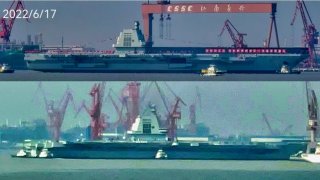China Is Now Officially Armed with a Fleet of Powerful Aircraft Carriers
China's third aircraft carrier, the Type 003 Fujian, has embarked on its first sea trials, marking a significant milestone in the expansion of the People's Liberation Army Navy (PLAN).
Summary: China's third aircraft carrier, the Type 003 Fujian, has embarked on its first sea trials, marking a significant milestone in the expansion of the People's Liberation Army Navy (PLAN).
-Launched from Shanghai's Jiangnan Shipyard, the Fujian is the largest carrier in the PLAN's fleet, boasting a displacement of 80,000 metric tons and featuring advanced Catapult-Assisted Take-Off & Barrier Arrested Recovery (CATOBAR) capabilities with an electromagnetic catapult system (EMALS).
-These trials will primarily assess the reliability of the carrier's propulsion and electrical systems. The Fujian's development is part of China's broader naval strategy to enhance its blue-water capabilities and project power globally, with plans to expand its carrier fleet to six by 2035.
China's Type 003 Fujian Begins Sea Trials: A New Era in Aircraft Carrier Capabilities
China’s third aircraft carrier has begun sea trials, according to state-run media. Xinhua announced that the Type 003 Fujian departed Shaghai’s Jiangnan Shipyard on May 1.
These first sea trials will test the “reliability and stability of the aircraft carrier’s propulsion and electrical systems,” reads the Xinhua report. “Since its launch in June 2022, the Fujian has completed its mooring trials, outfitting work, and equipment adjustments. It has met the technical requirements for sea trials.”
The Type 003 Fujian was launched by Jiangnan Shipyard in June 2022. It is the People’s Liberation Army Navy’s (PLAN’s) third aircraft carrier, and the service’s first flattop to be configured for Catapult-Assisted Take-Off & Barrier Arrested Recovery aircraft operations.
Largest Chinese Aircraft Carrier to Date
The conventionally powered Type 003 displaces 80,000 metric tons, dwarfing the PLAN’s two active carriers, the 66,000-ton Type 002 Shandong and the 60,000-ton Type 001 Liaoning. Only the U.S. Navy’s Nimitz-class and Gerald R. Ford-class nuclear-powered supercarriers are larger, with the former class displacing around 87,000 metric tons, and the newer Ford class displacing 100,000 metric tons.
The Fujian’s electromagnetic catapult system, or EMALS, puts it on par with the Navy’s newest carrier, the USS Gerald R. Ford (CVN-78)—the Navy’s 10 older Nimitz-class carriers rely on steam-powered catapults to launch aircraft. However, EMALS has had significant bugs, and the PLAN will likely face problems of its own with the system.
Moreover, U.S. carriers have more catapults, larger airways, and more elevators.
What the Trials Mean
The Type 003 will not enter service until at least 2026. As USNI News reported, the Type 002 Shandong—China’s first domestically built carrier—conducted nine sea trials from May 2018 to November 2019. That carrier wasn’t exactly a great leap forward in design. It was largely based on the Type 001, which was laid down as a Soviet aircraft cruiser before being sold by Ukraine to China.
The sea trials for the Fujian could be lengthy as the carrier tests its new systems.
“The Fujian’s sea trials represent an important milestone for the PLAN, marking its entry into the small club of top-class carrier aviation-capable navies,” John Bradford, a Council on Foreign Relations fellow, told CNN,
“These sea trials mark the first major step in China’s developing the capacity to project sea-based air power into deep ocean areas,” added Carl Schuster, a former U.S. Navy captain and former director of operations at the U.S. Pacific Command’s Joint Intelligence Center
As the Fujian begins sea trials, it is a reminder that Beijing is seeking to close the gap with the U.S. Navy. China has set a goal of having six carriers in service by 2035.
Author Experience and Expertise: Peter Suciu
Peter Suciu is a Michigan-based writer. He has contributed to more than four dozen magazines, newspapers, and websites with over 3,200 published pieces over a twenty-year career in journalism. He regularly writes about military hardware, firearms history, cybersecurity, politics, and international affairs. Peter is also a Contributing Writer for Forbes and Clearance Jobs. You can follow him on Twitter: @PeterSuciu. You can email the author: [email protected].
Image: Screenshot Via X.


